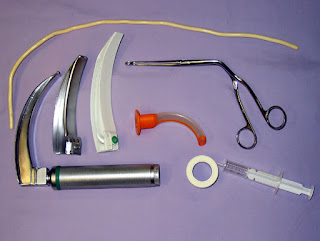 |
| Photo: Wikimedia Commons |
Author: Valery Victoria Rivas Cuesta, MSVI
Medical Student
Universidad Iberoamericana (UNIBE) School of Medicine
An emergency physician’s failure to secure the airway can rapidly lead to death or disability. In the emergency setting, patients are assumed to have a full stomach and be at risk for aspiration. Often, rapid-sequence intubation (RSI) represents the preferred method to secure the airway in the ED setting, as it results in unconsciousness (induction) and neuromuscular blockade (paralysis) rapidly thereafter.[1]
 |
| This post was peer reviewed. Click to learn more. |
The procedure has the following main goals: prevention of hypoxia, shortening the time between induction and intubation, minimizing aspiration risk, and improving first pass success.[1] This is achieved by the “ritual of the P’s”:[2]
RSI is often the preferred method of managing the airway in the emergency setting. Multiple studies report that the implementation of RSI has resulted in improved success and decreased complication rates for emergency intubations.[5] Therefore, the ability to perform a proper RSI is a core skill for any emergency physician to acquire. Know these “Precious P’s” and how to use them; you will undoubtedly help save a life.
References:
- Stewart, JC. Bhananker, S. Ramaiah, R. Rapid-sequence intubation and cricoid pressure. Int J Crit Illn Inj Sci. 2014;4(1):42-9.
- Airway Management. Emergency Medicine Residents Association. http://emra.org. Available at: https://www.emra.org/uploadedfiles/emra/emra_publications/books/tcp.pdf. Accessed July 11, 2015.
- Rapid Sequence Intubation: Medications, dosages, and recommendations. School of Medicine of Missouri. http://med.umkc.edu. Available at: http://med.umkc.edu/docs/em/Intubation_Chart. Accessed July 11, 2015.
- Butler J, Sen A. Best evidence topic report. Cricoid pressure in emergency rapid sequence induction. Emerg Med J. 2005;22(11):815-6.
- Bair AE. Rapid sequence intubation in adults. UpToDate. http://uptodate.com. April 4, 2015. Available at:: http://www.uptodate.com/contents/rapid-sequence-intubation-in-adults#subscribeMessage. Accessed June 8, 2015
- Braude D. The Ten P’s of Rapid Sequence Intubation. Emergency Medicine News. 2007;29(1):8-12.
- Rapid Sequence Intubation Pharmacology. American College of Emergency Physicians ACEP Now. http://acepnow.com. Available at: http://www.acepnow.com/article/rapid-sequence-intubation-pharmacology/2/?singlepage=1. Accessed July 15, 2015.
- Robinson N, Clancy M. In patients with head injury undergoing rapid sequence intubation, does pretreatment with intravenous lignocaine/lidocaine lead to an improved neurological outcome? A review of the literature. Emerg Med J. 2001;18(6):453-7.
- Levitan R. No Desat! Emergency Physicians Monthly. http://epmonthly.com. December 9, 2010. Available at: http://www.epmonthly.com/archives/features/no-desat-/. Accessed July 18, 2015.
